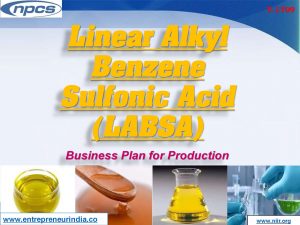Linear Alkyl Benzene Sulfonic Acid (LABSA) Business Plan for Production

Introduction
(LABSA) Linear alkyl benzene sulfonic acidic is used to make anionic, non-anionic, and amphoteric surfactants, and its degradability in nature is crucial. It’s a water-soluble emulsifying agent. Because of its low cost, high performance, and biocompatibility due to its linear chain, alkyl benzene sulfonic acid is one of the most commonly used anionic surfactants. Hydrophilic and hydrophobic groups coexist in this anionic surfactant. The sulfonation process produces these non-volatile compounds. These compounds are made up of phenyl and sulfonate groups in carbon chains ranging from 10 to 14 carbons long.
Related Projects: – Production of Linear Alkyl Benzene Sulphonic Acid
Linear Alkyl Benzene Sulphonic Acid’s Specific Uses
Linear alkyl benzene sulfonic acid is primarily used in the manufacture of household detergents such as laundry powders, liquids, and other cleaners, as well as in a variety of industrial applications such as coupling agents and emulsifiers for agricultural herbicides and emulsion polymerization.
In the first phases of the sewage-treatment process, a significant portion of the LAS is eliminated from the aqueous phase of the wastewater due to adsorption on the sludge or sedimentation in the presence of calcium or magnesium. When reacting with calcium, the LAS homologs with the longest alkyl chain have a higher propensity to adsorb on solids and become less dissolved.
Related Books: – The Complete Technology Book on Chemical Industries
Production of Linear Alkyl Benzene Sulphonic Acid
The sulphonation reaction of Alkyl Benzene with Sulphur trioxide produces LABSA (Linear Alkyl Benzene Sulphonic Acid) (SO). Other processes can call for the use of oleum or sulfuric acid. The final decision will be influenced by a number of factors, including raw material availability, plant location, plant size, and plant operation mode, to name a few. Nonetheless, when major factors such as cost, availability, versatility, and protection are taken into account, SO remains the reaction’s preferred reagent.
LABSA is one of the most popular active ingredients in soaps and detergents. It also makes up a higher percentage of the raw materials used in the manufacture of liquid soaps. Chemithon and Ballestra are two of the major producers. Both companies use the same steps to create LABSA. However, the technology differs slightly, particularly at the sulphonation level, where Chemithon uses a Falling Film Reactor or Jet Reactor and Ballestra uses a Stirred Tank Reactor/Cascade Reactor or Multitube Falling Film Reactor.
Market Outlook
The market for linear alkyl benzene sulfonic acid can be divided into three categories: type, purity, and application. The market can be divided into two types: alpha-olefin sulfonate (AOS) and alkyl sulphate (AS). The market can be divided into linear alkyl benzene sulfonic acid (90 percent) and linear alkyl benzene sulfonic acid (90 percent) based on purity (96 percent).
The global market can be divided into two categories based on application: soap and detergent and personal care. One of the active ingredients used in the soap and detergent industry is linear alkyl benzene sulfonic acid. It has outstanding foaming and consistency characteristics. North America, Asia Pacific, Europe, Latin America, and the Middle East and Africa are the regions in which the global linear alkyl benzene sulfonic acid market can be divided. The demand for linear alkyl benzene sulfonic acid is dominated by Asia Pacific, followed by Europe. Rise in population in Asia Pacific developing economies, improvement in people’s lifestyles, and increased focus on investment.
Related videos: – Chemicals (Organic, Inorganic, Industrial)
Rise in population in developing economies of Asia Pacific, improvement in lifestyle of the people, and increase in emphasis on improving hygiene standards in the food & beverages industry are propelling the demand for linear alkyl benzene sulfonic acid in Asia Pacific. Germany, the United Kingdom, and France are Europe’s top consumers of linear alkyl benzene sulfonic acid, owing to their large customer bases. The largest consumers of linear alkyl benzene sulfonic acid in Europe are Germany, the United Kingdom, and France, owing to their large customer bases and rising demand for dishwashing cleaners and liquids. The linear alkyl benzene sulfonic acid market in the region is also benefiting from an increase in demand for industrial cleaners to maintain industrial hygiene.
In North America, the United States is the largest producer of linear alkyl benzene sulfonic acid. The global Linear Alkyl Benzene Sulphonic Acid market is projected to expand at a CAGR of 3.5 percent from 2021 to 2026, from 3606.9 million USD in 2021 to 4601.4 million USD by the end of 2026.
Key Players: –
- Nirma Ltd.
- Reliance Industries Ltd.
- Tamilnadu Petroproducts Ltd.
For More Details, Click Here: – Handbook on Chemical Industries